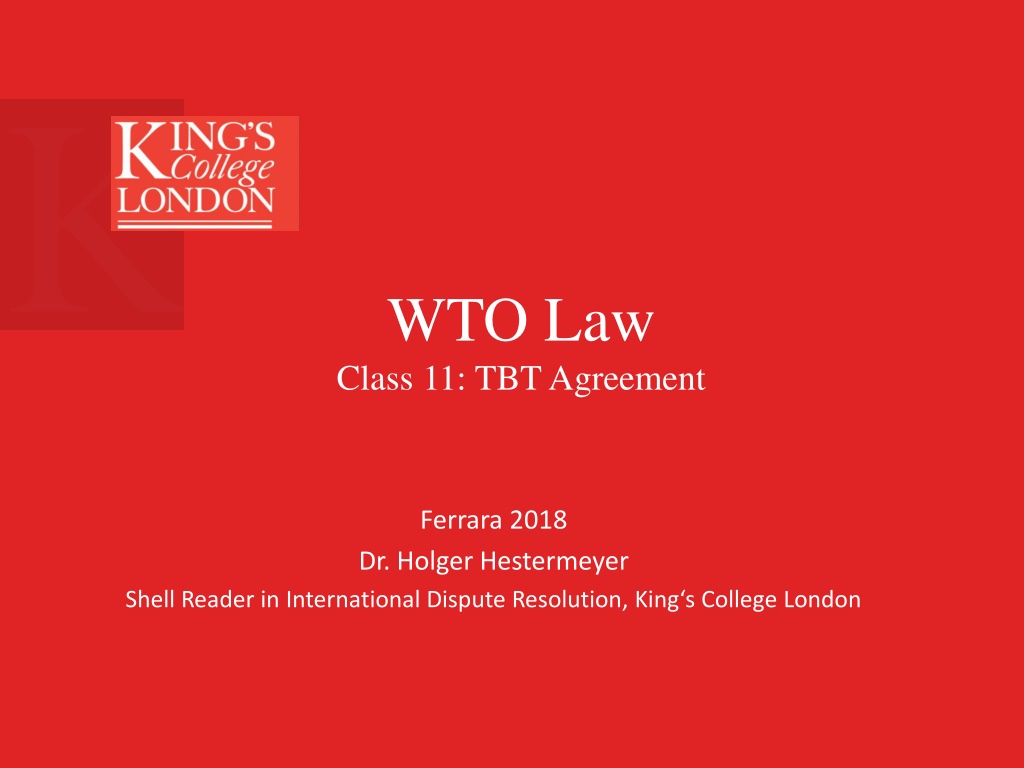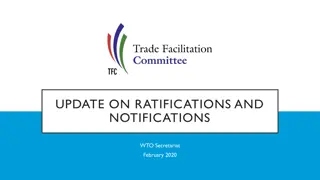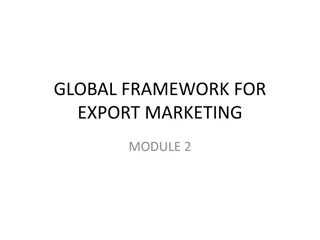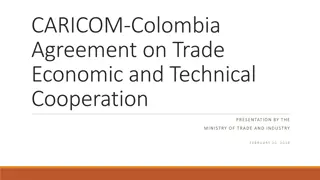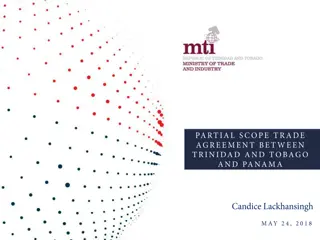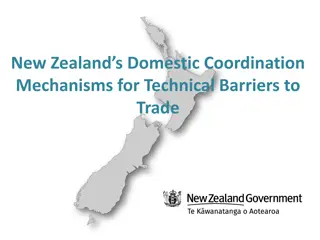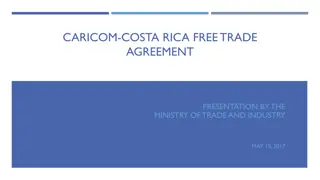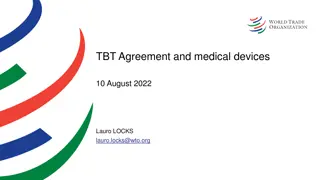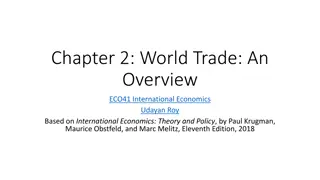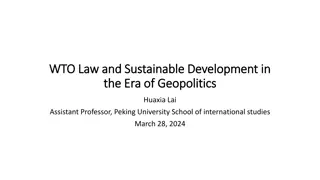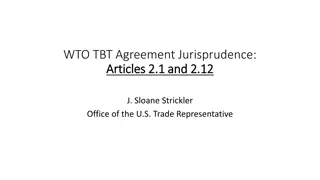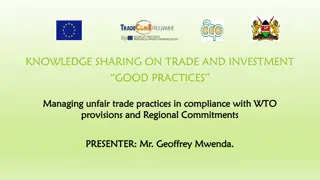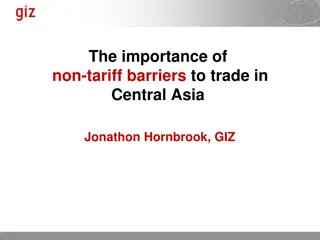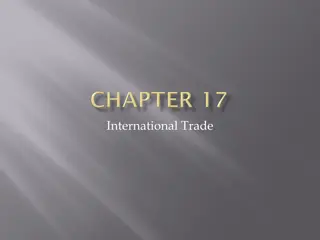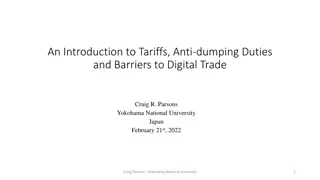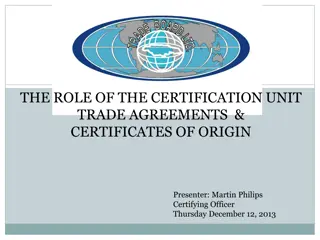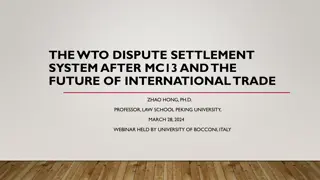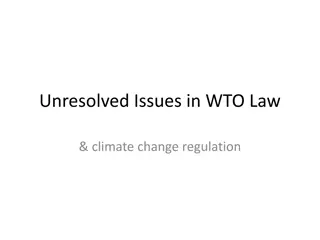Overview of Technical Barriers to Trade (TBT) Agreement in WTO Law Class
The Technical Barriers to Trade (TBT) Agreement under WTO law addresses regulatory divergence costs on trade, covering information, specification, and conformity assessment for products and processes. It aims to harmonize technical regulations and standards while ensuring compliance without discrimination. Examples of TBT measures include EC Sardines, US Clove Cigarettes, and US Tuna II cases. The agreement applies to technical regulations, standards, and conformity assessment procedures for products and processes, emphasizing the importance of normative content and nexus to product characteristics.
Uploaded on Sep 14, 2024 | 1 Views
Download Presentation

Please find below an Image/Link to download the presentation.
The content on the website is provided AS IS for your information and personal use only. It may not be sold, licensed, or shared on other websites without obtaining consent from the author. Download presentation by click this link. If you encounter any issues during the download, it is possible that the publisher has removed the file from their server.
E N D
Presentation Transcript
WTO Law Class 11: TBT Agreement Ferrara 2018 Dr. Holger Hestermeyer Shell Reader in International Dispute Resolution, King s College London
Barriers to Trade Tariff Barriers Negotiate down Non-tariff Barriers Ban (Art. XI) Don t discriminate (Art. I, III) SPS: harmonize, use science TBT?
Introduction Origin/Purpose (preamble + implicit link with GATT Art XX) Regulatory divergence costs on trade: Information (obtaining info) Specification (complying with export market regs) Conformity assessment (showing compliance) Rationalization of domestic policies beyond NT Scope of application Art 1.3 all products Tech regulations, standards (Artt 2-4 + annex 1) Conformity assessment (CA) (Artt 5-9) GATT relation: note to annex 1A (SPS Art1.5) Not: SPS, Government Procurement
Examples EC Sardines: prestriptions for sale of preserved sardines including that only one species of sardines could be sold as such EC Trademarks and Gis: country of origin must be indicated on product label (also US COOL) US Clove Cigarettes: US ban on clove cigarettes and other favours exception menthol US Tuna II (Mexico): dolphin-safe label
Relevant measures TBT Agreement applies to (see Annex) 1. Technical regulation Document which lays down product characteristics or their related processes and production methods, including the applicable administrative provisions, with which compliance is mandatory. It may also include or deal exclusively with terminology, symbols, packaging, marking or labelling requirements as they apply to a product, process or production method. 2. Standards Document approved by a recognized body, that provides, for common and repeated use, rules, guidelines or characteristics for products or related processes and production methods, with which compliance is not mandatory. [ ] 3. Conformity Assessment Procedures Any procedure used, directly or indirectly, to determine that relevant requirements in technical regulations or standards are fulfilled
What are TBT? Relating to documents (broad range (US Tuna II), but with regard to technical regulations must have normative content (EC Seal Products)) Measure must relate to products or processes and production methods Also to non-product-related PPMs? Those PPMs that do not affect the physical characteristics of the final product? Art. 1.1 of the Annex or their related PPMs -> method related to product characteristics, a sufficient nexus to the characteristics of the product in order necessary Note language on labelling requirements in Art. 1.1 and 1.2: related is not included. Labelling for non-product related PPMs subject of several cases, not argued that they fall outside scope of TBT Agreement Technical regulation (AB in EC-Asbestos, EC-Sardines): It must be a document It must apply to an identifiable (not necessarily named) product or group of products It must lay out product characteristics (including extrinsic ones relating to presentation and appearance, label is a product characteristic), maybe only one, positive or negative Mandatory compliance Standard: approved by recognized body : Annex 1.2, technical regulation typically by government body; standards: not just characteristics, also rules and guidelines
Standard or Regulation? US Tuna II Conditions for use of dolphin-safe label US: standard, not technical regulation: compliance only mandatory if you need the label to place product for sale on the market, tuna can be sold without the label AB: determination must be made in light of the features of the measure and circumstances of the case, may involve considering 1) is it a law or regulation 2) does it prescribe or prohibit particular conduct 3) specific requirements as sole means of addressing matter 4) nature of the matter In this case: federal legislation & regulation, single definition of dolphin-safe and disallows other labels, so the only legal way of making dolphin-safety assertion -> technical regulation
Is the EU Seal Regime a Technical Regulation (excluding PPM) Ban on importation and marketing seal products Exception: derived from indigenous hunting, dervied from hunts conducted for marine resource management, imported into personal use Panel: product characteristics (based on ban) AB: No you have to consider the whole measure including exception -> prohibition based on identity of hunter and purpose of hunt, so not product characteristics
Obligations Main obligations (re tech regulation) Art 2.1 NT and MFN Art 2.2 more trade-restrictive than necessary Art 2.4 harmonisation (intern.l standards) Other obligations (re tech regulation) Regulatory cooperation (Artt 2.5-2.6) Regulatory equivalence (Art 2.7) (obligation to consider) Base technical regulations on performance rather than charcteristics (Art. 2.8) Regulatory transparency (Art 2.9 & 2.11) Obligations (re CA procedures and recognition) NT & MFN (Art 5.1.1) + unnecessary (5.1.2) + harmonization (5.5) Recognition of equivalent procedures (Art 6.1) Mutual recognition agreements are encouraged (Art 6.3) SDT (Art. 12); TBT Committee, Technical Assistance, Dispute Settlement (Art. 14)
Non-discrimination MFN & National treatment Technical regulations: Art. 2.1 Standards: Annex 3.D Conformity assessment: Art. 5.1.1 Note: no Art. XX Art. 2.1: three-tier test Technical regulation Like products Treatment no less favourable than like domestic products OR like products orginating in another country Like product: sufficiently strong competitive relationship Less favourable treatment (both de jure and de facto discrimination) Modifies conditions of competition in the market to the detriment of the group of imported products (not actual trade effects) AND Where we are examining de facto discrimination: whether the detrimental impact on the imports stems exclusively from a legitimate regulatory distinction rather than reflecting discrimination against the group of imported products (for this: design, architecture, revealing structure, operation and application of the technical regulation and whether it is even-handed, focusing on regulatory distinction causing detrimental impact) SOURCE: contest, objecte and purpose of TBT, 6th recital
Necessity Technical regulations: Art. 2.2; standards: Annex 3.E; conformity assessment: Art. 5.1.2 Art. 2.2: one four-tier test of consistency Technical regulation Trade restrictive (having limiting effect on trade) Fulfils legitimate objective Not more trade-restrictive than necessary Legitimate objective Whicht objective: to be assessed on the basis of text, legislative history, structure and operation Legitimate? Third sentence lists examples, but not exhaustive, guidance also in preamble, other WTO agreements, for complainant to prove fulfil ( degree of contribution that the TR actually makes toward achieviment of the legit objective , actual contribution to be ascertained from the measure s design, structure, operation and application , AB EC-Tuna II Not more trade-restrictive than necessary Compare Degree of contribution made by measure to legitimate objective; Trade-restrictiveness of the measure; nature of risks at issue and gravity of consequences arising from non-fulfillment of the objectives In most cases comparison with alternative measures ( less restrictive, equivalent contribution, reasonably available )
International standards Regulations: 2.4, Standards: Annex 3.F, Conformity Assessment: Art. 5.4 Art. 2.4: Where [ ] relevant international standards exist [ ], Members shall use them, or the relevant parts of them, as a basis for their technical regulations except when such international standards or relevant parts would be an ineffective or inappropriate means for the fulfilment of the legitimate objectives pursued [ ]. Three-tier test relevant international standard (international standard: defined by characteristics of entity, int l standardising body may by IO, membership should be open to relevant bodies of at least all WTO Members; relevant standard: same product, similar types of requirements) as a basis for (employ as principal constituent or fundamental principle) Is the international standard effective and appropriate for fulfilment of legitimate objectives pursued (bears upon results of the means employed and on the nature of the means employed i.e. capacity to accomplish objectives and suitable for fulfilment)
